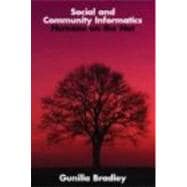
Note: Supplemental materials are not guaranteed with Rental or Used book purchases.
Purchase Benefits
Looking to rent a book? Rent Social and Community Informatics: Humans on the Net [ISBN: 9780415381857] for the semester, quarter, and short term or search our site for other textbooks by Bradley; Gunilla. Renting a textbook can save you up to 90% from the cost of buying.
| List of illustrations | viii | ||||
| Preface | x | ||||
| List of abbreviations | xiii | ||||
| 1 Introduction | 1 | (28) | |||
|
1 | (4) | |||
|
5 | (2) | |||
|
7 | (9) | |||
|
16 | (1) | |||
|
16 | (11) | |||
|
27 | (1) | |||
|
28 | (1) | |||
| 2 Theoretical perspective on the psychosocial and organizational life environment and ICT | 29 | (34) | |||
|
30 | (22) | |||
|
52 | (6) | |||
|
58 | (3) | |||
|
61 | (2) | |||
| 3 Information and communication technology (ICT) past, present and future | 63 | (9) | |||
|
63 | (1) | |||
|
64 | (8) | |||
| 4 ICT and humans – ongoing changes in working life | 72 | (23) | |||
|
72 | (1) | |||
|
73 | (7) | |||
|
80 | (3) | |||
|
83 | (1) | |||
|
84 | (5) | |||
|
89 | (4) | |||
|
93 | (2) | |||
| 5 Home of the future and ICT integration of professional and private roles | 95 | (35) | |||
|
95 | (1) | |||
|
96 | (1) | |||
|
97 | (1) | |||
|
98 | (1) | |||
|
98 | (3) | |||
|
101 | (1) | |||
|
102 | (4) | |||
|
106 | (5) | |||
|
111 | (5) | |||
|
116 | (1) | |||
|
117 | (9) | |||
|
126 | (4) | |||
| 6 ICT and humans – ongoing changes in communities | 130 | (22) | |||
|
130 | (2) | |||
|
132 | (3) | |||
|
135 | (1) | |||
|
136 | (4) | |||
|
140 | (2) | |||
|
142 | (1) | |||
|
143 | (8) | |||
|
151 | (1) | |||
| 7 ICT and pychosocial communication | 152 | (20) | |||
|
152 | (5) | |||
|
157 | (2) | |||
|
159 | (1) | |||
|
160 | (1) | |||
|
161 | (7) | |||
|
168 | (2) | |||
|
170 | (2) | |||
| 8 ICT and stress | 172 | (25) | |||
|
172 | (7) | |||
|
179 | (1) | |||
|
180 | (2) | |||
|
182 | (7) | |||
|
189 | (4) | |||
|
193 | (1) | |||
|
194 | (3) | |||
| 9 From theory to actions: how to achieve the good ICT society – a tree of action | 197 | (40) | |||
|
199 | (5) | |||
|
204 | (1) | |||
|
205 | (3) | |||
|
208 | (1) | |||
|
208 | (5) | |||
|
213 | (4) | |||
|
217 | (9) | |||
|
226 | (7) | |||
|
233 | (4) | |||
| Appendices | 237 | (14) | |||
| References | 251 | (8) | |||
| Index | 259 |
The New copy of this book will include any supplemental materials advertised. Please check the title of the book to determine if it should include any access cards, study guides, lab manuals, CDs, etc.
The Used, Rental and eBook copies of this book are not guaranteed to include any supplemental materials. Typically, only the book itself is included. This is true even if the title states it includes any access cards, study guides, lab manuals, CDs, etc.